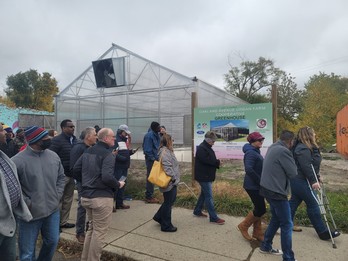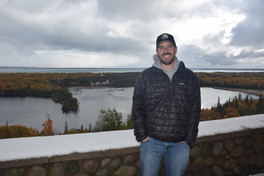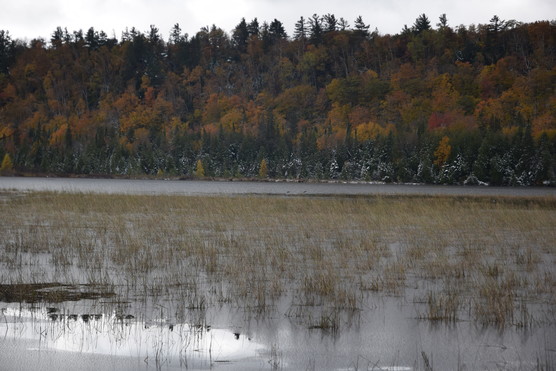
NRCS-Michigan had the opportunity to show off its urban agriculture accomplishments when the agency’s National Leadership Team met in Detroit during the week of October 17. State conservationists from across the country came to Detroit along with NRCS Chief Terry Cosby.
The group visited several urban gardening sites including Keep Growing Detroit, Oakland Avenue Urban Farm, Fisheye Farms, and Central Detroit Christian urban farm. NRCS leaders saw first-hand the dynamic role urban farming has in Detroit. NRCS has been working with urban farmers in the Detroit area for over a decade. Local partners, like the Southeast Michigan Resource Conservation and Development Council and Keep Growing Detroit played an important role in getting producers enrolled in NRCS programs. Partner organizations continue to play an important role in promoting NRCS to urban producers and we plan to have an urban USDA office in Detroit soon.
~
Each November we recognize American Indian and Alaska Native Heritage Month. NRCS-Michigan is proud of the working relationship we have developed with each of our state’s 12 Federally Recognized American Indian Tribes. Over the years NRCS has worked to make our programs responsive to the needs of tribal communities. In Michigan, this has included helping tribes re-establish wild rice as a traditional part of their diet and culture, supporting local food production through high tunnels and walleye rearing ponds, reconnecting stream systems to improve habitat for fish and other aquatic life, and other projects and practices that support resources important to Michigan’s tribal communities. NRCS staff members have found working with tribal communities to be a rewarding experience and we continue to value this important partnership.
~
The new year officially started for NRCS on October 1. Cut-off dates were announced for the first round of funding for the Environmental Quality Incentives Program, several projects funded through the Regional Conservation Partnership Program, along with the Agricultural Conservation Easement Program. We start the new fiscal year with many new employees who are now seasoned and ready to hit the ground running. Each year has its challenges and 2023 will be no exception but we begin the year in a good place.
|
 Attendees at the NRCS National Leadership Team meeting in Detroit on a tour of Oakland Avenue Urban Farm.
NRCS accepts applications for its programs on a continuous basis. On designated cut-off dates, applications are ranked and selected for funding. Applications received after the cut-off date will be retained for subsequent funding opportunities. The following cut-off dates were announced for fiscal year 2023 funding:
Nov. 18 - Wetland Reserve Easements
Dec. 2 - Environmental Quality Incentives Program (general EQIP)
Dec. 2 - Lower Grand River Watershed Habitat Restoration and Farmland Conservation
Dec. 2 - Thornapple-Kalamazoo Water Quality Project
Dec. 2 - Western Lake Erie Basin
Dec. 16 - Improving Forest Health for At-Risk Wildlife Resources Partnership

Wild rice holds a special place in the culture of American Indians in the Great Lakes region. The Bay Mills Indian Community is attempting to restore wild rice as both a part of tribal members’ diet, and culture.
“The goal is to make harvesting opportunities for tribal members,” said Frank Zomer, lead fisheries biologist for the tribe.
In addition to being a traditional food source for the tribe, wild rice (referred to as manoomin by the Anishinaabe people) also has a place in the ecosystem, said Zomer. Manoomin provides food and habitat for aquatic wildlife and waterfowl. NRCS provides financial assistance to American Indian tribes for planting manoomin through the Environmental Quality Incentives Program.
The Bay Mills Indian Community began planting wild rice in Spectacle Lake, near its tribal headquarters in Brimley, in the 1990s, said Zomer. Due to feeding by Canada geese and other factors, the rice beds in Spectacle Lake slowly shrunk. Spectacle Lake is separated from the St. Mary’s River by a small strip of land near where the river joins Lake Superior. An adjacent bluff offers a spectacular view of the lake and river with the Canadian shore to the north.
Spectacle Lake was a natural site for planting wild rice since it is easily accessible by tribal members. The tribe renewed its planting efforts with financial assistance through EQIP beginning in 2021. Due to the difficulty in establishing wild rice, EQIP provides financial assistance for three years of seeding at each location. After two years of seeding, the wild rice beds on Spectacle Lake have grown from 13 acres to 20, said Zomer. The size of the beds is important because geese, which have the greatest impact on wild rice beds, tend to only feed on the outside fringes.
Wild rice is an annual plant that is very sensitive to disturbance, it can be easily uprooted in its early stages before it establishes a seed head above the water. Geese and spawning carp can both uproot wild rice in its early stages as can abrupt changes in water levels.
In addition to Spectacle Lake, the tribe utilized EQIP assistance to begin planting wild rice on Waiska Bay on the St. Mary’s River in 2022. On Waiska Bay, the tribe used tracking information to avoid planting wild rice in areas identified as spawning areas for carp which are aggressive spawners, said Zomer.
Wild rice is planted by broadcasting the seed by hand from canoes or kayaks around the third week of August. Wild rice seed is shaped like a torpedo and sinks directly to the bottom, it’s a perfectly designed seed, said Zomer.
This year tribal staff and volunteers planted about 5,200 pounds of seed at a rate of 50 pounds per acre. The rice is is purchased from tribes in Wisconsin and Minnesota who have more established wild rice plantings. The biggest challenge the tribe faces in establishing wild rice is obtaining seed. They only purchase seed from tribal harvesters and Bay Mills tribal staff travel to Minnesota and Wisconsin to pick it up. There is no shortage of potential sites for planting, Zomer said.
Wild rice has been absent from the region long enough that no one in the tribe has direct experience with harvesting or processing it. Some tribal members heard stories from relatives about harvesting rice but none of them took part themselves, said Zomer. Next year the Bay Mills Tribe is planning to hold a rice camp with the Sault Ste. Marie Tribe of Chippewa Indians where attendees will learn the traditional methods of harvesting and processing wild rice.
|
 Wild rice bed on Spectacle Lake near Brimley.

The USDA Natural Resources Conservation Service, in honor of American Indian and Alaska Native Heritage Month, has dedicated a poster with art from Derek No-Sun Brown, entitled “Three Sisters.”
American Indian and Alaska Native Heritage Month is observed from November 1 through November 30. During this time, NRCS celebrates and recognizes intertribal cultures and takes the opportunity to educate the public about the heritage, history, art, and traditions of American Indians and Alaska Natives. Furthermore, we respect and honor tribal sovereignty by working on a government-to-government basis with Tribal Nations to protect and enhance tribal natural resources.
This year’s artwork theme is “The Three Sisters of Indigenous American Agriculture.”
“This piece is a visual representation of the three sister plants corn, beans, and squash. In the painting, the sacred foods are represented as young women all working together sharing in their harvest. The first figure is the corn sister standing tall and strong holding an ear of Indian corn in her right hand. In the middle is the bean sister wrapping her vines gently around her sister. The bean sister is shown holding the basket of harvest because she is the middle and integral piece to the family. At the far end is the strong and resilient squash sister, who is holding a small pumpkin in her hands. Together they are the three sisters who not only nourish but protect the people,” said No-Sun when describing “Three Sisters.”
Derek No-Sun Brown is an entrepreneur and artist who is blessed to be carrying on ancestry from the Shoshone Bannock, Klamath and Anishinabe people. Born in 1986, He was raised with a strong traditional foundation and continues to maintain indigenous ways of prayer and philosophy that is evident through his art. No-Sun grew up on the Fort Hall Indian Reservation in Idaho and the Boise Forte Reservation in northern Minnesota.
|

An NRCS-funded project that is restoring stream habitat and protecting farmland in northwest Michigan is the subject of a documentary film which premiered in October on WCMU Public Television.
The subject of the film is the Tribal Stream and Michigan Fruitbelt Collaborative project funded through the USDA Regional Conservation Partnership Program. The film focuses on the project's accomplishments and the many partners who made them possible. The 30-minute documentary, Restoring Aquatic Ecosystems, includes interviews with NRCS staff, Senator Debbie Stabenow and representatives of project partners including the project's lead partner, the Grand Traverse Band of Ottawa and Chippewa Indians.
The documentary was created by Nature Change and is available for viewing online at naturechange.org.
|
Sharcy Ray - District Conservationist - Grand Haven (formerly District Conservationist Gaylord and Resource Conservationist - Longmont, Colo.)
Stacey Smith - Area Resource Soil Scientist - Flint (formerly Soil Conservationist - Lapeer)

November
7 - Macroinvertebrate ID night for Citizen Scientists, 6:30‐8:30 p.m., Olivet College - Olivet, for more information and to register email rachel.cuschieri-murray@macd.org or call 517/543-1512 ext. 5
10 - Pollinate 2022 Conference Series, 10 a.m. to 3 p.m., Shawhaven Farm - Mason, for more information go eatoncd.org
17 - Workshop for Farmland Preservation, 10 a.m. (lunch provided), SW Michigan Research & Extension Center - Benton Harbor, for more information and to register call the Berrien Conservation District at 269/471-9111 or email nancy.carpenter@macd.org
22 - Strategies for 2023 Farm Inputs, 7 p.m. to 8:30 p.m., Zoom Webinar, for more information go to canr.msu.edu/events
December
6-8 - Great Lakes Fruit, Vegetable & Farm Market Expo, Devos Place - Grand Rapids, for more information go to glexpo.com
19 - Integrated Crop and Pest Management Update, 9 a.m. to 4 p.m., MSU Livestock Pavilion - East Lansing or online, for more information go to www.canr.msu.edu
|
|